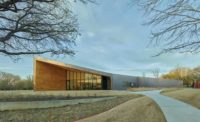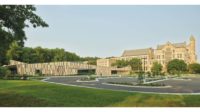From the bird’s-eye perspective of Google Earth, nothing in central Fayetteville or the adjacent University of Arkansas has a larger footprint than the new Fayetteville High School. Its two buildings, each 600 feet wide by 250 feet deep, appear like a supersize equal sign sitting on a hillside site.
Additional Information:Jump to credits & specifications
Designed by DLR Group, Hight Jackson Associates, and Marlon Blackwell Architects, this 535,000-square-foot project was commissioned by Fayetteville Public Schools to accommodate a growing student body. Faced with an antiquated, undersized facility as well as pressure from the community to keep the central location, the city officials opted to expand and improve the existing 33-acre campus rather than split it into two smaller, distinct institutions. According to school administrator Alan Wilbourn, the district student population has not reached the 14,000-student tipping point to justify two high schools. Large enough for as many as 3,000 students, the modernized campus, built in two phases, was completed in 2015. In the first phase, which took two years, a new steel-frame and concrete-block structure that replaced elements of the existing school was built on the southern side of the site, near the bottom of the slope. It houses the sports and performing-arts facilities, and the cafeteria. The 36-month second phase involved an addition to the existing classroom building—similar in form and materials to the earlier project—while incrementally renovating much of the existing structure, all without disrupting the school schedule.
We took “a big-box approach,” says Marlon Blackwell, whose firm was the design architect on the project. This minimalist strategy, with a spare use of detail, resulted in two massive building blocks that are articulated with large-scale bands of curtain wall windows and sculptural elements such as bridges and stairways that connect the major volumes.
The scheme is defined by a bold cross-axis circulation pattern that features a broad, boulevard-like plaza, named Green Street, that stretches east–west along the 600 feet between the main buildings. A narrower north–south axis follows the slope and traverses a series of broad staircases. The route begins at the main entry of the first-phase building, which is closer to a major road. Moving up the hill, under a glazed circulation bridge and through an open commons, it intersects Green Street and passes underneath the school’s new library, which is raised to form another, wider bridge. The procession crosses a verdant courtyard at the heart of the classroom building and ends at the north portal, which connects to the athletic field complex.
The exterior material palette is a study in restraint. “Northwest Arkansas isn’t really a red-brick kind of place,” Blackwell says. “I joke that our cash crop is rocks.” The design team used a 2-inch-thick veneer of local sandstone at the buildings’ base, while charcoal-hued verticalrib metal siding wraps the upper part. The use of simple materials and building forms were key in keeping construction costs within the $80 million budget.
The effect of the massing and materials is a bit austere from the street. But the rich play of spaces on the interior, along with the masterful organization of the major elements, creates dynamic and varied gathering spaces and contributes to Blackwell’s aim of making the high school a more “collegiate” experience.
The interior organization highlights an innovative approach to big-school design. Recent research shows that smaller schools often lead to better academic outcomes. A 2007 University of Michigan Study of 789 high schools found that the ideal size is between 600 to 900 students. The study suggests that larger schools could resolve the issue of size by subdividing the student body into “schools-within-a-school.”
The architects designed Fayetteville High School to accommodate four small learning communities (SLCs), averaging around 700 students each. Although they have yet to be integrated into the school’s programming, each SLC will be made up of an autonomous set of students with a core group of teachers who would have access to a variety of rooms such as flexible multimedia labs, maker spaces (woodworking shops, robotics labs, etc.), and bleacher-like grand staircases that transform into mini-auditoriums or places to hang out.
In addition to the generous glazing around the perimeter of the buildings, the architects installed skylights and clerestories at strategic locations within the deep floor plates, introducing natural light throughout the windowless internal areas. “Open project labs,” for instance, which provide flexible alternatives to the traditional classrooms within the heart of the second-phase building, are flooded with daylight. Additionally, clerestory windows in the sports arenas and common spaces combine with bands of south-facing glazing to illuminate key public spaces. These and other sustainable features, including the use of recycled building materials and energy-efficient environmental-control systems contributed to LEED Gold certification for the second building and LEED Silver for the first.
Between classes, students pour into the central courtyard and enliven the three grand staircases in the classroom building, where they socialize or get a bite to eat. Sophomores Michael Lynn McNeill and Evie Ritter often have lunch on one of these daylit stairs. Both students found the transition to the large campus from middle school a bit overwhelming. But would they prefer a smaller school? McNeill replies, “No, I like the diversity of people in a big school, and the fact that it has the feel of a college campus.
CreditsArchitect: Hight Jackson Associates, PA
Personnel in architect's firm who should receive special credit: Hight Jackson
Architect of record: Hight Jackson Associates
Associate architects: DLR Group, Marlon Blackwell Architects
Engineers Structural Engineer: DLR Group, Tatum-Smith Engineers, Inc.
Consultants Landscape Architect: McClelland Consulting Engineers
General contractor: Construction Manager = Nabholz Construction Services
Photographer: Timothy Hursley
|
SpecificationsStructural System Steel frame Manufacturer of any structural components unique to this project: Jacksonville Steel, Inc. Exterior Cladding Masonry: Schwartz Stone Company Metal panels: Morin & Firestone Precast concrete: Coreslab Moisture barrier: Tyvek Curtain wall: Kawneer Products Elastomeric: Carlisle Syntec Glazing Glass: Tri-Star Skylights: Insulated-panel or plastic glazing: Other: Doors Entrances: Kawneer Products Wood doors: Marshfield Door System Sliding doors: EFCO Fire-control doors, security grilles: Won Door Corporation Hardware Locksets: Genetic Closers: LCN Exit devices: Von Duprin Pulls: Sargent Security devices: Genetic Interior Finishes Acoustical ceilings: Armstrong Suspension grid: Armstrong Cabinetwork and custom woodwork: Stevens Industries, Inc. Paints and stains: Sherwin Williams Plastic laminate: Wilson Art, Pionite, Formica, Nevamar Floor and wall tile: American Olean Resilient flooring: Armstrong Carpet: Bigelow Furnishings Fixed seating: Irwin Seating Co. Lighting Interior ambient lighting: Essentia Exterior: Philips Gardco Dimming system or other lighting controls: Curtis Stout Conveyance Elevators/escalators: Thyssen Krupp Elevator Accessibility provisions: Garaventa Lift Plumbing American Standard & Acorn Aqua Energy Energy management or building automation system: Trane Photovoltaic system: Essentia |

















Post a comment to this article
Report Abusive Comment